Oncology
Relapsed/Refractory Diffuse Large B-Cell Lymphoma
Relapsed/Refractory Diffuse Large B-Cell Lymphoma: Assessing the Treatment Goals
Overview
In relapsed/refractory diffuse large B-cell lymphoma (R/R DLBCL), cure is a possibility even in the second and third line. For those who cannot proceed to potentially curative therapies, or for those who relapse after such treatment, active options include loncastuximab tesirine, tafasitamab plus lenalidomide, or polatuzumab vedotin plus bendamustine and rituximab (Pola-BR).
Expert Commentary
Jeremy S. Abramson, MD, MMSc
|
|
“For those who would never be considered candidates for CAR T-cell therapy, or for those who relapse after CAR T-cell therapy, we would still be thinking about other options, including anti-CD19 regimens (eg, tafasitamab plus lenalidomide or loncastuximab tesirine) or Pola-BR.”
The goal of therapy in the first relapse of DLBCL is almost always to cure the patient, and cure may be possible even in second- and third-line settings.
In the first relapse, we encourage a confirmatory biopsy, and then we consider transplant eligibility. For young and healthy patients who are transplant eligible, we would consider administering second-line therapy (ie, rituximab, ifosfamide, carboplatin, and etoposide phosphate [R-ICE regimen]; rituximab, gemcitabine, dexamethasone, and cisplatin [R-GDP regimen]; or rituximab, dexamethasone, cytarabine, and cisplatin [R-DHAP regimen]). And, for patients who are chemosensitive, we would then proceed to high-dose chemotherapy (HDC), with the combination of carmustine, etoposide, cytarabine, and melphalan (BEAM) being a preferred HDC regimen for autologous stem cell transplantation (ASCT). Fewer than half of patients have disease that is sufficiently chemosensitive to proceed to transplant. And, even in chemosensitive patients, the cure rate with ASCT is less than 50%. So, although this is the standard of care, we also need to be thinking about other potentially curative options. Two recent phase 3 clinical trials (ie, TRANSFORM and ZUMA-7) have reported improved outcomes for chimeric antigen receptor (CAR) T-cell therapy with either lisocabtagene maraleucel (liso-cel) or axicabtagene ciloleucel (axi-cel) compared to a standard HDC and ASCT approach, and they are likely to make CAR T cells a potentially curative option in the second-line setting for relapsed DLBCL.
For patients who undergo ASCT but relapse afterwards, assuming that cure is still the goal, we would then proceed to an anti-CD19 CAR T-cell therapy, which cures approximately 40% of patients in the R/R setting. Likewise, for those who had originally been on the path to ASCT but who did not respond to second-line salvage chemotherapy, we would use CAR T-cell therapy in the third-line setting. Patients who are not eligible for ASCT are often eligible for CAR T-cell treatment, which does not involve HDC. We would treat these individuals with a less intensive second-line chemotherapy regimen and then consider them for CAR T-cell therapy in the third-line setting.
For those who would never be considered candidates for CAR T-cell therapy, or for those who relapse after CAR T-cell therapy, we would still be thinking about other options, including anti-CD19 regimens (eg, tafasitamab plus lenalidomide or loncastuximab tesirine) or Pola-BR.
As previously stated, the goal of therapy for the first relapse in R/R DLBCL is usually to cure the patient; however, the rare exceptions are in individuals with advanced age, severe medical comorbidities, or severely impaired performance status that would make any treatment challenging and where the risks would outweigh the benefits of treatment. When cure is not the treatment goal, we should consider more palliative regimens up front. The consideration of clinical trial participation should be part of the conversation from the beginning and at every juncture point when treatment is being discussed.
References
Abramson JS. Anti-CD19 CAR T-cell therapy for B-cell non-Hodgkin lymphoma. Transfus Med Rev. 2020;34(1):29-33. doi:10.1016/j.tmrv.2019.08.003
Bristol Myers Squibb announces positive topline results from phase 3 TRANSFORM trial evaluating Breyanzi (lisocabtagene maraleucel) versus chemotherapy followed by stem cell transplant in second-line relapsed or refractory large B-cell lymphoma. News release. Bristol Myers Squibb. June 10, 2021. Accessed June 10, 2021. https://bit.ly/3zg9qx7
ClinicalTrials.gov. Efficacy of axicabtagene ciloleucel compared to standard of care therapy in subjects with relapsed/refractory diffuse large B cell lymphoma (ZUMA-7). Updated October 14, 2021. Accessed October 29, 2021. https://clinicaltrials.gov/ct2/show/NCT03391466
Gisselbrecht C, Van Den Neste E. How I manage patients with relapsed/refractory diffuse large B cell lymphoma. Br J Haematol. 2018;182(5):633-643. doi:10.1111/bjh.15412
Kite submits supplemental biologics license application to US Food and Drug Administration for earlier use of Yescarta® in large B-cell lymphoma. News release. Gilead Sciences, Inc. September 30, 2021. Accessed October 29, 2021. https://bit.ly/3mkJbA7
Maziarz RT, Waller EK, Jaeger U, et al. Patient-reported long-term quality of life after tisagenlecleucel in relapsed/refractory diffuse large B-cell lymphoma. Blood Adv. 2020;4(4):629-637. doi:10.1182/bloodadvances.2019001026
Oluwole OO, Bishop MR, Gisselbrecht C, et al. ZUMA-7: a phase 3 randomized trial of axicabtagene ciloleucel (axi-cel) versus standard-of-care (SOC) therapy in patients with relapsed/refractory diffuse large B cell lymphoma (R/R DLBCL). J Clin Oncol. 2018;36(suppl 15):TPS7585. doi:10.1200/JCO.20218.36.15_suppl.TPS7585
Sehn LH, Salles G. Diffuse large B-cell lymphoma. N Engl J Med. 2021;384(9):842-858. doi:10.1056/NEJMra2027612
Wang L, Li L-R, Young KH. New agents and regimens for diffuse large B cell lymphoma. J Hematol Oncol. 2020;13(1):175. doi:10.1186/s13045-020-01011-z











